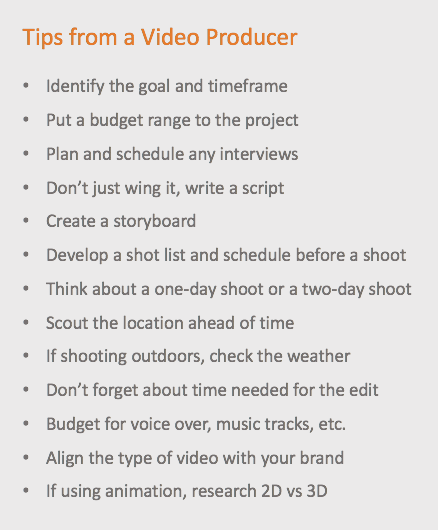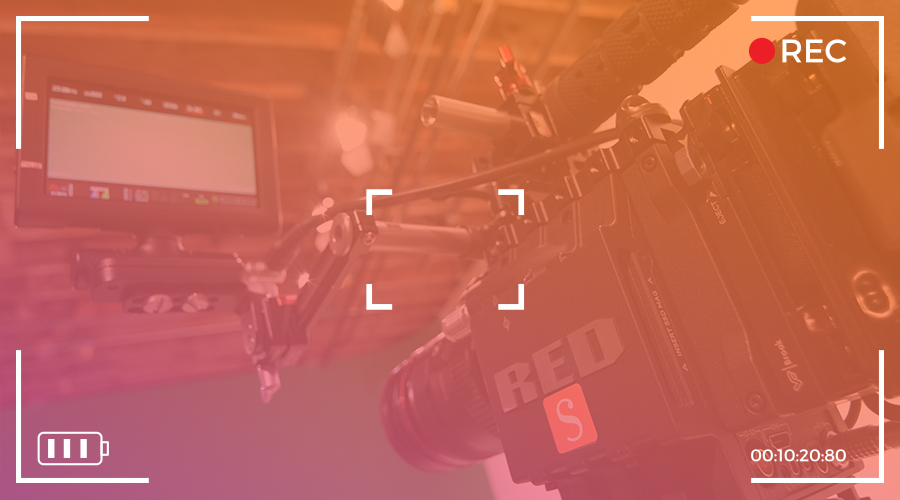I’ll start by being honest, producing a professional marketing video is not cheap.
But 81 percent of businesses use video as a marketing tool, up from just 63 percent last year. More importantly, 84 percent of consumers have bought something after watching a video.
It’s not new that video has overwhelming influence on consumers, and all marketers (even those living under a rock) understand by now the value of video—but it becomes a little more complicated in the B2B space.
The Long B2B Sales Cycle
B2B marketers deal with the challenge of a very long-tail sales cycle. It’s rare in this space to show a product one time and then cash in on an immediate sale. B2B isn’t your ideal show-the-kid-a-toy-and-their-parent-runs-out-the-next-day-to-buy-it kind of marketing.
Us B2B folks are trying to market products and services that often aren’t cut and dry. They might be a big investment for the customer’s business, so the consumer needs ample time and information to contemplate the decision to buy. While many studies will show you that the gap between B2B and B2C sales cycles is getting smaller because of digital, it still needs to be a consideration when laying out your marketing plans for a B2B brand and the journey that your consumer takes.
And video plays a key part in that journey. Although video can be very costly, it can yield great results. But it takes a concerted effort to research your consumers’ wants and needs and then activate on those insights. This is key in resonating with your target audience and, ultimately, driving performance.
Tips from a Video Producer
I’ve worked with our video team closely over the years to estimate video projects for potential new clients. And I’ll be honest, this can be difficult. Here’s why: there are an infinite number of directions you can take when it comes to creating a video. We’ve done videos from hundreds of dollars, all the way to hundreds of thousands of dollars. Starting with a blank canvas is one of the most challenging parts when the world is your oyster.
So, where do you start?
I went straight to the best source I know – Simantel’s senior video producer. Leslie Williams has been our producer for more than six years, and with hundreds of videos and countless shoots across the world under her belt, she has some tips to share for scoping your next video project.
First, set some parameters. Start with a budget; I know this can be difficult, but at least start with a range. This will help identify what’s realistic to accomplish. Also, consider your timeframe – is there an event driving the need for a video? A trade show, a heavy recruiting period, a trending hashtag? Then (and most importantly), think long and hard about your goal. What are you trying to communicate? What is the intended outcome you want from someone watching your video?
When it comes to making the most of your video budget, Leslie will be the first to tell you: plan, plan, plan. Pre-planning as much as possible is the biggest way to gain efficiencies and save money.

Here are some other tips from Leslie to take into account:
- Make sure everyone is on the same page regarding the goal, the plan and the concept before pulling the trigger on production. Also, identify roles and responsibilities to streamline concepting and production. This will save time and money from any unnecessary rework.
- Do as much pre-production as possible. If you are doing a testimonial video, identify ahead of time who you are interviewing. It’s helpful to outline the discussion ahead of time and send it to them to make them feel more prepared. Also, find out their location. Traveling between interviews (think packing, unpacking, setting up, tearing down, repacking and doing it all over again) can be costly. When it comes to video, time is money.
- Don’t just wing it; take the time to make a plan. This means write a script, have a shot list for your shoot and create a schedule for the day or work through a storyboard.
- If planning a live shoot, take a look at what realistically can be accomplished in a one-day shoot vs. two-day shoot. Travel costs, overnight stays and feeding the crew are all expenses that are easily forgotten in the estimating stage.
- Take time to scout the location ahead of time. This can save you time and eliminate the risk of unknowns.
- While you’re at it, check the weather. If you’re doing any outdoor shooting, this can make or break your day.
- Consider the time needed for the edit. The clearer the direction, the more streamlined the editing process will be. This goes back to pre-planning with a storyboard. Remember, an editor is going through hours and hours of footage. And again, time is money.
- Don’t forget to budget for motion graphics, professional voice over talent, music tracks, sound design and creating intros/outros – these are other aspects of the project that can easily be forgotten.
- And lastly, do your research on what type of video you want and what type fits your brand voice the best. Consider live only, animation only or a mix of the two. Animation could be more cost effective, but there is a wide variation of types of animation.
Related Post: Aligning Video with Your Brand
Different Types of Videos
One of the more popular types of video is live action. We’ve had the honor of working with clients like Knapheide Manufacturing and First Response Team of America to produce a variety of different types of styles. You’ll see in the first example below that with a one-day shoot we were able to capture some really great B-roll and tell the story with a strong voice over. The second example for First Response Team includes more interviews that were captured over a two-day shoot.
Here’s what a video created from a one-day shoot looks like:
Here’s what a video created from a two-day shoot looks like:
Animation is a style that continues to grow with the marketing industry. Our partners at Caterpillar do a great job at taking something complex and educating clients through animation and visual storytelling. Take a look at the examples below of the difference between 2D animation and 3D animation. When planning your project, keep in mind that 2D can be more cost effective and turned around quicker if on a tight deadline.
Here is what 3D animation looks like.
Here is what 2D animation looks like.
Build a Whole Ecosystem
Not too long ago, we had a prospect interested in creating a new video. It was simply a one-off project. We went back and forth fine-tuning details, talking through options, and then we asked the question, “How are you going to use this video?” The client wasn’t really sure. I mean, they thought about it, but really hadn’t put a plan together.
As I said before, video isn’t inexpensive so it’s really important to think through how you can make the most of the investment. And we love this kind of work – looking at it as a whole and helping with a strategy. A video that is well produced, compelling, funny or unique will not perform well if no one sees it. This is when we can start thinking of making a video part of a comprehensive marketing plan. This can include a specific landing page, social ads, banners, a giveaway – all targeted at your ideal customer. Think about how you can turn “just a video” into a whole campaign. And on a bigger note, think about how this campaign fits into the overall customer journey. Consumers crave the immersive experience. The video may be used as your hook and as part of your larger strategy.
Related Post: The Hook vs. The Strategy
Here are a few ideas to tie your video into your overall strategy:
- If running media, a new audience can be created based on views. And with video, you can get much more precise than measuring views on a still image. Did a viewer watch the video for 10 seconds, 30 seconds, 3 minutes? Their level of engagement means different things when it comes to qualifying a lead. This audience can now be used for targeting efforts.
- Consider using a platform that allows you to collect leads in your CRM. This way, a video of high value can be used as gated content. The viewer is required to enter an email address in order to hit the play button. Just use this function with caution, make sure the content includes exclusive information or is enticing enough for a viewer to give their email address.
- Think about what happens after the video. Consider including a specific CTA for what a viewer should do next after they watch the video in its entirety. Maybe it’s serving them a correlating whitepaper.
- Include video in your email campaigns. Videos in email are known to increase open rates by 10 percent and clickthrough rates by as much as 65 percent.
Planning the Plan
Even though the direction of your video may be dictated by the budget, there are still many options to produce quality work.
And I’ll say it, one of the biggest clichés in marketing: Make sure to plan as much as possible but remain flexible for change. I know, that sounds like the biggest oxymoron and it’s hard to do both, but it’s essential when creating a professional marketing video. But Leslie will tell you, every video project is different, and you need to be able to flex when the unexpected happens.
At the heart of it, that’s what the long-tail sales cycle is all about. To reach your customers, you have to flex with them at every point of the buying journey. Good video creative can yield unbelievable results if you can just identify where your audience is tuned in.





